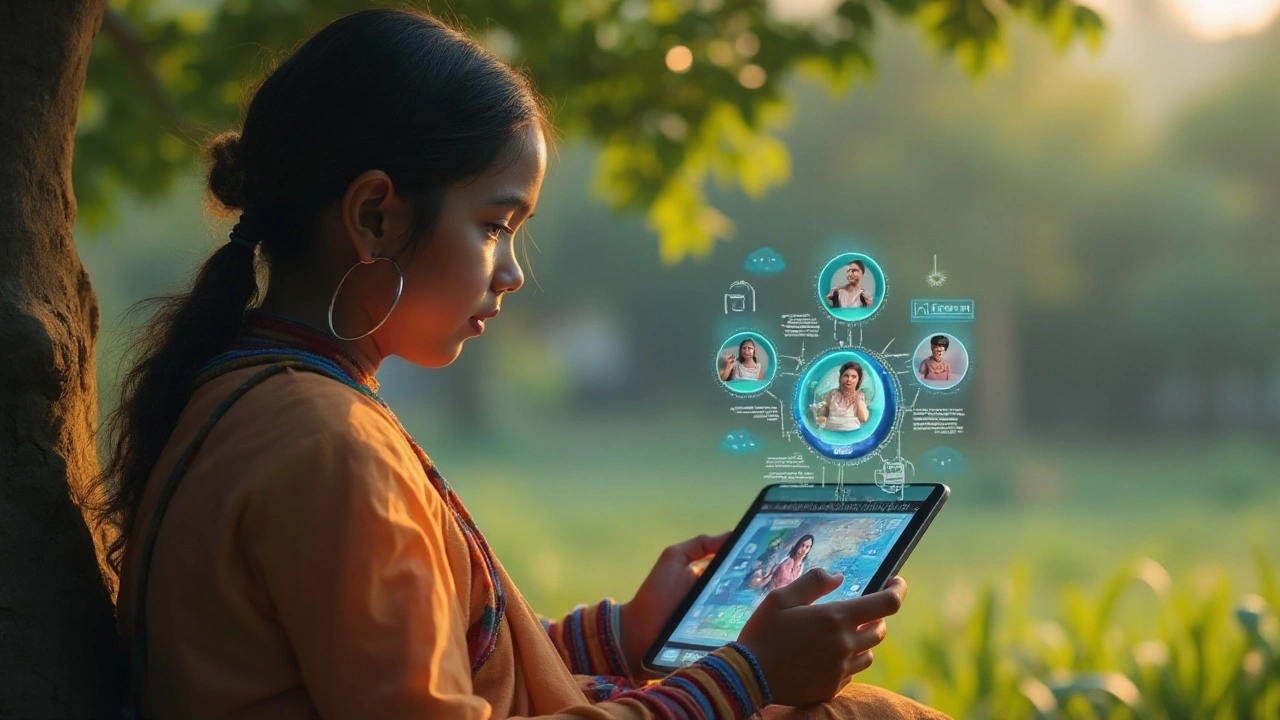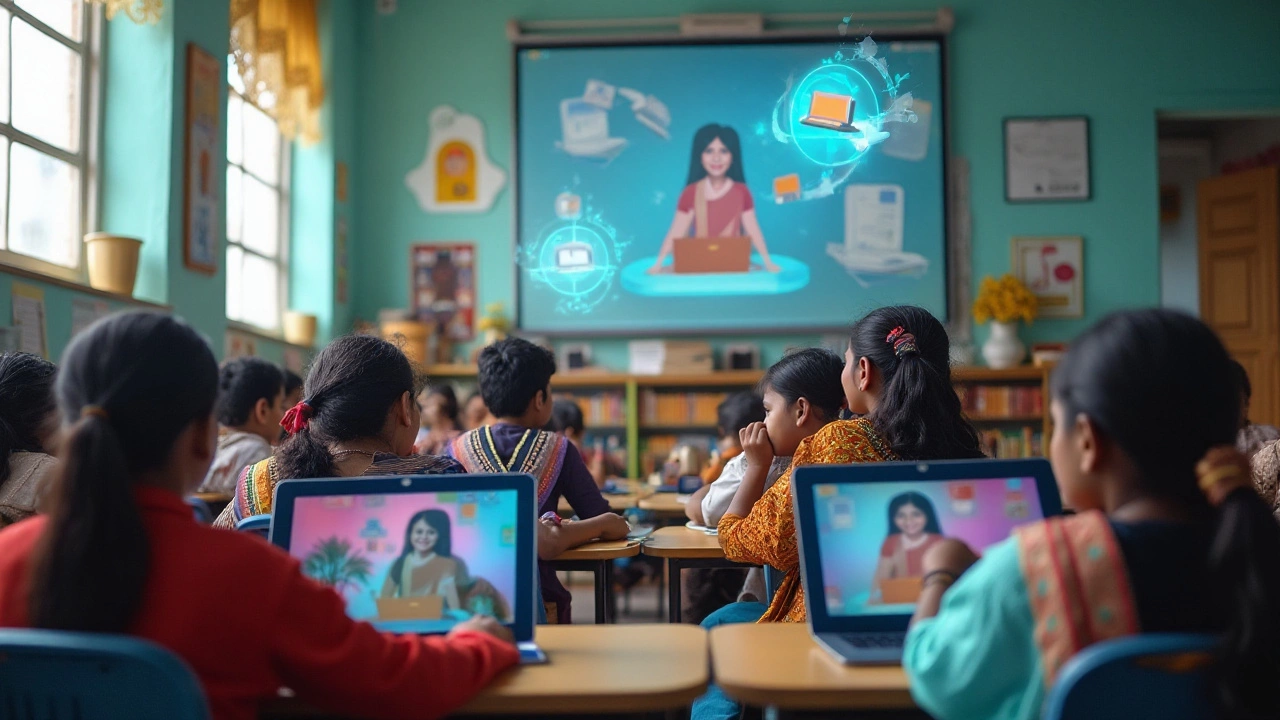In an age where technology and education intersect seamlessly, distance learning has become a cornerstone of modern education systems. Unlike traditional classrooms bustling with students and a lively teacher, this new mode of learning offers a unique twist. It’s about more than just sitting in front of a screen; it's an experience tailored to fit the digital age.
Let's start by exploring how distance learning has evolved over the years, what tools and technologies have been developed to support it, and how learners can harness these resources to enhance their educational journey. From virtual classrooms that mimic the feel of physical spaces to adaptive learning technologies, there's a lot to unpack about how distance learning operates today.
- The Evolution of Distance Learning
- Core Technologies and Platforms
- Engaging in Virtual Classrooms
- Strategies for Success in Online Learning
- Future Trends in Distance Education
The Evolution of Distance Learning
Distance learning has undergone a fascinating transformation, branching off from its humble beginnings to become an integral part of the educational landscape. In the early days, correspondence courses were the primary form of learning from a distance. Students would receive lessons by mail, complete their work, and send it back for grading. This method certainly offered flexibility, but it lacked the immediacy and interaction that many students craved.
The advent of the internet in the late 20th century marked a significant turning point in this field. Suddenly, access to a wealth of information was at one’s fingertips, and educational institutions quickly saw the potential to reach a broader audience. Institutions began offering courses online, incorporating multimedia elements that provided a richer learning experience. This new format dramatically changed how both students and educators approached the idea of education.
Technological Advancements
With each subsequent technological advancement, distance learning became increasingly sophisticated. Video conferencing introduced the concept of the virtual classroom, allowing real-time interaction between students and teachers from anywhere in the world. Online discussion forums and chat rooms created opportunities for learners to engage with each other, fostering a sense of community despite geographical distances.By the time the world entered the new millennium, platforms dedicated to online education began to appear, each offering a unique approach to teaching digitally. Tools like Learning Management Systems (LMS) became a staple in educational institutions, facilitating course content delivery, assessment, and communication in one integrated space. The growing popularity of social media in the 21st century even led some institutions to incorporate elements of these platforms into their distance learning models, recognizing the value of informal learning environments.
"Education is the most powerful weapon which you can use to change the world," said Nelson Mandela. His words resonate powerfully in this context, as distance learning has indeed revolutionized access to knowledge on a global scale.
Adapting to Change
As the world approached the 2020s, the COVID-19 pandemic forced a dramatic shift toward remote teaching and learning. Educational institutions worldwide were pushed to adopt or enhance their e-learning capabilities rapidly. This sudden shift proved challenging but also served as a catalyst for innovation. It highlighted the resilience of distance learning platforms and underscored the importance of continuous innovation in education technology.Today, students enjoy unprecedented access to educational resources. The rise of Artificial Intelligence has started to tailor learning experiences to individual needs. Adaptive learning technologies assess a student's progress in real-time and adjust the material accordingly. This personalized approach has been a game changer, providing a more efficient and effective way to learn, catering to different learning styles, and helping students thrive in their educational journeys.
Looking Ahead
With technology continuing to evolve, the future of distance learning remains bright. New trends such as virtual reality and augmented reality are already being incorporated into some courses, offering immersive experiences that traditional classrooms can’t match. These innovations promise to enhance engagement and retention, making distance learning a dynamic and essential segment of the global education fabric.Core Technologies and Platforms
When it comes to distance learning, the technologies and platforms in use today have developed significantly from their early days. Initially seen as an auxiliary form of education, the technologies have transformed into sophisticated ecosystems making online education a mainstream choice. At the heart of this transformation are mainstays such as Learning Management Systems (LMS), which serve as the backbone for virtual classrooms. Platforms like Moodle, Canvas, and Blackboard are household names in education now, accommodating thousands of students globally with their intuitive designs and robust functionalities. They not only store course materials but facilitate interactions between students and instructors through forums, quizzes, and assignments, mirroring the interactive elements of a traditional classroom but with the added convenience of accessibility and flexibility.
Video conferencing tools have also become pivotal in e-learning, with Zoom and Microsoft Teams leading the charge, especially since the global pandemic accelerated the move to online platforms. These tools allow for synchronous learning experiences, where real-time interaction can replicate face-to-face learning environments. The integration of breakout rooms in platforms like Zoom fosters group work and collaboration, vital components of modern education. An interesting fact about Zoom is that daily meeting participants jumped from ten million in December 2019 to 300 million in April 2020, underscoring the accelerated adoption of such tools.
Beyond the infrastructure provided by LMS and video conferencing applications, the role of specialized educational apps cannot be ignored. Apps such as Kahoot and Quizlet provide interactive learning opportunities that encourage student engagement and have turned learning into an active, rather than passive, activity. Augmented Reality (AR) and Virtual Reality (VR) are also making their entrances on the stage of distance learning. They offer immersive experiences that can transport students to different eras, countries, or microscopic worlds, all from their screens. Although still emerging, these technologies promise to further change the face of online education once their accessibility and affordability improve.
Infrastructure isn't only about the systems and software; the data analytics that these platforms provide are equally significant. Instructors can now tailor their teaching strategies based on analytics from platforms that show student engagement, proficiency in specific areas, and attendance patterns. This real-time data allows for a responsive and dynamic educational experience, addressing student needs promptly. According to a study by the Online Learning Consortium, courses that utilized data-driven decisions saw a 20% increase in student success rates, clearly showcasing the impact of this approach.
Security, on the other hand, is an underlying pillar for any distance learning platform. Protecting student information and maintaining a secure environment for learning modules is crucial. Technologies such as HTTPS protocols, multifactor authentication, and data encryption are employed to ensure that online education environments remain safe for learners and educators alike. According to the Center for Online Education, the successful implementation of security measures directly correlates with student confidence in virtual classrooms.
"Technology has enabled an unprecedented opportunity to learn with few barriers of accessibility and convenience," notes Tony Bates, a respected voice in online education. "As we continue to innovate, we must ensure our students' experience is enriched—not just by platform features, but through an understanding of how they learn best."
The evolution of these technologies has been driven not by the tools themselves but by the users of these technologies—a focus that keeps the human aspect at the core. As we proceed through 2025, the future promises even more sophisticated enhancements with AI-driven personal assistants and more immersive experiences on the horizon. Knowing the current array of technologies and platforms is just the first step in a never-ending journey that will redefine education as we know it.

Engaging in Virtual Classrooms
Virtual classrooms have emerged as a powerful component of distance learning, creating interactive spaces where students and teachers connect, regardless of geographical boundaries. As opposed to the traditional in-person setup, a virtual classroom offers a digital venue for education, yet replicating many of the essential functions of a physical classroom. These classes often utilize video conferencing tools, such as Zoom or Microsoft Teams, to facilitate real-time communication between participants. What makes these classrooms unique is their ability to incorporate various digital tools to enhance interactivity and collaboration, such as shared whiteboards, instant polls, and breakout rooms for group discussions. This blend of technology not only accommodates a wide range of learning styles but also encourages greater participation from students who might be reticent in a traditional setting.
A key aspect of engaging in virtual classrooms lies in the design of the learning content and the strategies employed by instructors. Teachers now play a critical role in guiding the dynamics of these sessions. Some educators focus on creating a balanced mix of synchronous and asynchronous activities, allowing students to participate in live sessions while also working on projects at their own pace. Incorporating multimedia elements, such as videos and interactive quizzes, helps maintain student interest and fosters a deeper understanding of the subject matter. According to a report by the National Education Association, ‘students in well-structured virtual environments perform just as effectively, if not more so, than those in talks-and-chalk settings.'
The virtual classroom is not merely a digital bulletin board; it’s a bustling online community, rich with peer-to-peer interaction and collaborative learning opportunities.
Effective engagement in these virtual settings also hinges on the accessibility and user-friendliness of the technology employed. Students require platforms capable of supporting a seamless learning experience, with minimal disruptions from technical issues. High-speed internet and reliable devices are crucial to ensuring participants can engage fully without interruption. To aid in this transition, many schools have taken the initiative to provide technical support and resources to students and educators alike. Beyond the technology, fostering a sense of community and belonging is vital within the e-learning environment. Teachers might employ strategies like social check-ins or virtual classroom initiatives to promote interaction. Encouraging students to take active roles in discussions or peer-led sessions further increases involvement and helps build a tight-knit classroom environment, even if it's entirely online.
| Feature | Benefits |
|---|---|
| Breakout Rooms | Foster small group collaborations |
| Digital Whiteboards | Encourage visual learning and idea mapping |
| Interactive Polls | Gauge student understanding and feedback |
Finally, the success of a virtual classroom also hinges on the level of support and training educators receive. As the landscape of education shifts towards more digital formats, institutions increasingly recognize the necessity of providing educators with professional development opportunities that focus on mastering these technologies. Courses on digital teaching strategies and virtual classroom management are increasingly being offered, helping teachers develop the skills needed to navigate and thrive in these new environments. Through dedicated effort and open-mindedness from both students and teachers, the virtual classroom can become a dynamic and effective environment for learning.
Strategies for Success in Online Learning
Embarking on a journey through distance learning can feel daunting, especially when transitioning from conventional education settings. However, equipped with the right strategies, students can thrive in this modern learning environment. One critical approach is to establish a structured routine. Unlike traditional schooling, online education often offers the flexibility to choose when and how to engage with learning materials. Yet, setting a consistent schedule is vital for maintaining discipline and focus. The key is to carve out specific times for lectures, assignments, and breaks, treating these blocks of time with the same urgency as one would a physical classroom timetable. Consider using digital tools like calendar apps or task managers to keep track of deadlines and commitments, ensuring that nothing slips through the cracks.
Creating an effective learning environment is equally essential. Since the home environment can sometimes be rife with distractions, identifying a dedicated space exclusively for learning can significantly boost productivity. This space should be quiet, well-lit, and equipped with all necessary resources—be it books, notebooks, or a reliable computer connection. Engaging in classes or completing assignments from a consistent location helps create a mental association with learning, which can transform even small corners of your home into virtual classrooms. Additionally, it's important to communicate with household members about your study schedule to minimize disruptions.
Maintaining active participation in virtual classrooms is another cornerstone of success. Online learning platforms often come equipped with features that foster interaction, including discussion boards, live chats, and video conferencing. Make it a habit to contribute to discussions, ask questions, and seek clarification when needed. A proactive learner engages not only with the content but also with their peers and instructors, facilitating a richer understanding of the material. Building connections through virtual study groups or online forums can mimic the social aspects of traditional education, allowing for collaborative learning experiences. Anna Watkins, an education specialist, once remarked in Education Weekly,
"In a world driven by technology, interaction in virtual classrooms must transcend mere presence; it's about active engagement and creating a vibrant learning community."
To truly excel in the realm of e-learning, one must also hone effective communication skills. Since many online learning interactions lack non-verbal cues, clarity and precision in communication is paramount. Practice concise writing in emails and discussion posts, ensuring that the purpose and intent of your message is clear. Whether reaching out to instructors for help or collaborating with fellow students on a project, articulate communication can bridge the virtual divide and prevent misunderstandings. Finally, leveraging digital tools designed for online education can bolster learning outcomes. From note-taking apps and digital libraries to interactive simulations and educational podcasts, the internet is teeming with resources that can enhance understanding and retention of content. Explore various apps and platforms that align with personal learning styles, and make them part of your regular study routine. Remember, the flexibility of distance learning is a double-edged sword, offering freedom but also demanding self-discipline and initiative.

Future Trends in Distance Education
As we look towards the future, the trajectory of distance learning reveals a landscape painted with vibrant technological advancements and pedagogical innovation. With each passing year, the boundaries of digital education continue to expand, offering fresh opportunities for learners and educators alike. One of the most intriguing aspects of this evolution is the integration of artificial intelligence in crafting personalized learning experiences. AI-driven platforms analyze student data, adapting the curriculum to fit the unique learning styles and paces of individual students. This level of customization ensures that education is not a one-size-fits-all solution, but a tailored journey that addresses specific needs.
Beyond personalization, another trend making waves is the use of immersive technologies such as virtual reality (VR) and augmented reality (AR). These technologies transform the traditional learning environment by creating interactive and engaging simulations. For instance, history students can virtually walk through ancient civilizations, absorbing information in a manner far more impactful than through textbooks alone. Science students can perform experiments in simulations, where real-world lab constraints are removed. Through virtual classrooms enhanced by VR and AR, students gain firsthand experience in fields that were previously difficult to access.
The move towards micro-credentials and digital badges is gaining momentum as the job market demands increasingly specific skill sets. Traditional degrees are supplemented with targeted certificates that display proficiency in niche areas. These digital credentials are typically self-paced, allowing students to integrate them into their learning schedules. As this trend grows, partnerships between tech companies and educational institutions are thriving, leading to curriculums that prepare students for the demands of the modern workforce.
Interconnectivity in global education is enhanced by lifelong learning platforms that transcend geographical boundaries. Asynchronous learning methods have evolved to become more efficient and accessible, allowing students from various time zones to participate at their convenience. According to a study by the Online Learning Consortium, over two-thirds of higher education institutions now see online education as critical for their long-term strategies. A diverse, inclusive approach ensures that learners from different cultural backgrounds can contribute and gain perspectives from peers worldwide.
"Technology will not replace teachers, but teachers who use technology will probably replace those who do not," said Dr. Ray Clifford, a thought leader in educational technology. His words underline the symbiosis of tech and tutelage that the future of online education represents.
As exciting as these trends are, a recurring theme of digital literacy emerges as paramount. It's not just about having access to technology; it's about smartly utilizing these tools. Educators must be equipped with the skills to guide students through this digital realm, ensuring that technology acts as a bridge rather than a barrier. With innovations racing ahead at a breakneck speed, the focus remains on human-centered learning experiences that empower students to thrive in a connected world.
